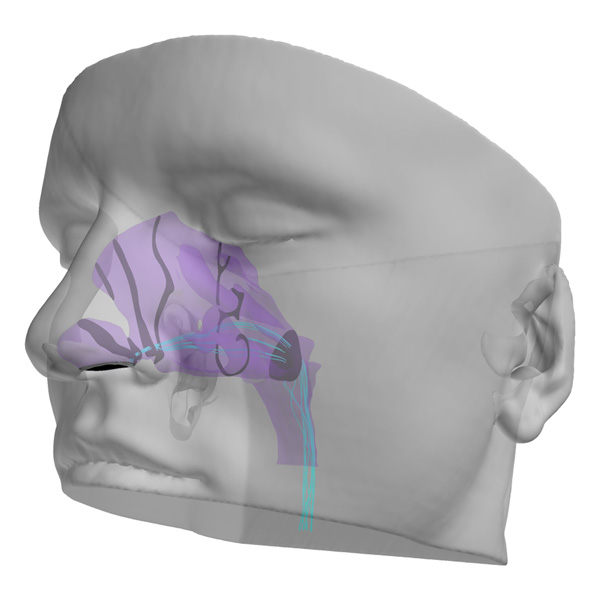Contact Us!
For more information on the Respiratory Biomechanics Laboratory, contact Dr. Guilherme Garcia.
Report a Problem
To report a problem with this website, contact BME Communications or report an accessibility issue.
 The Airway Lab is working to develop virtual surgery planning methods to optimize surgical outcomes for nasal airway obstruction (NAO). To achieve this goal, this project has several tasks, including:
The Airway Lab is working to develop virtual surgery planning methods to optimize surgical outcomes for nasal airway obstruction (NAO). To achieve this goal, this project has several tasks, including:
The video below illustrates the potential application of CFD simulations of nasal airflow in virtual surgery planning for NAO. The nasal anatomy and airflow patterns are compared pre- and post- virtual septoplasty and inferior turbinate reduction.
Virtual Endoscopy of the Nasal Cavity
This video was created in collaboration with the Marquette University Visualization Laboratory (MARVL).
Vicory J., Garcia G.J.M., Rhee J.S., Enquobahrie A. (2022) Toward automatic atlas-based surgical planning for septoplasty. International Journal of Computer Assisted Radiology and Surgery 17, 403-411.
Cherobin G.B., Voegels R.L., Pinna F.R., Gebrim E.M.M.S., Bailey R.S., Garcia G.J.M. (2020) Rhinomanometry versus computational fluid dynamics: Correlated, but different techniques. American Journal of Rhinology & Allergy, in press. DOI: 10.1177/1945892420950157.
Campbell D.A., Moghaddam M.G., Rhee J.S., Garcia G.J.M. (2020) Narrowed posterior nasal airway limits efficacy of anterior septoplasty. Facial Plastic Surgery & Aesthetic Medicine, in press. DOI 10.1089/fpsam.2020.0081.
Moghaddam M.G.,* Garcia G.J.M.,* Frank-Ito D.O., Kimbell J.S., Rhee J.S. (2020) Virtual septoplasty: A method to predict surgical outcomes for patients with nasal airway obstruction. International Journal of Computer Assisted Radiology and Surgery 15, 725–735.
* These authors contributed equally to this work.
Borojeni A.A.T.,* Garcia G.J.M.,* Moghaddam M.G., Frank-Ito D.O., Kimbell J.S., Laud P.W., Koenig L.J., Rhee J.S. (2020) Normative ranges of nasal airflow variables in healthy adults. International Journal of Computer Assisted Radiology and Surgery 15, 87-98.
* These authors contributed equally to this work.
Casey K.P., Borojeni A.A.T., Koenig L.J., Rhee J.S., Garcia G.J.M. (2017) Correlation between subjective nasal patency and intranasal airflow distribution. Otolaryngology—Head and Neck Surgery 156, 741-750.
Garcia G.J.M., Hariri B.M., Patel R.G., Rhee J.S. (2016) The relationship between nasal resistance to airflow and the airspace minimal cross-sectional area. Journal of Biomechanics 49, 1670-1678.
Hariri B.M., Rhee J.S., Garcia G.J.M. (2015) Identifying patients who may benefit from inferior turbinate reduction using computer simulations. Laryngoscope 125, 2635-2641.
Garcia G.J.M., Rhee J.S., Senior B.A., Kimbell J.S. (2010) Septal deviation and nasal resistance: An investigation using virtual surgery and computational fluid dynamics. American Journal of Rhinology & Allergy 24, e46-e53.
The team at the Airway Biomechanics Laboratory is always looking for hard-working researchers with an interest in respiratory physiology and computational modeling. For more information on becoming a member of our research team, contact Dr. Garcia.